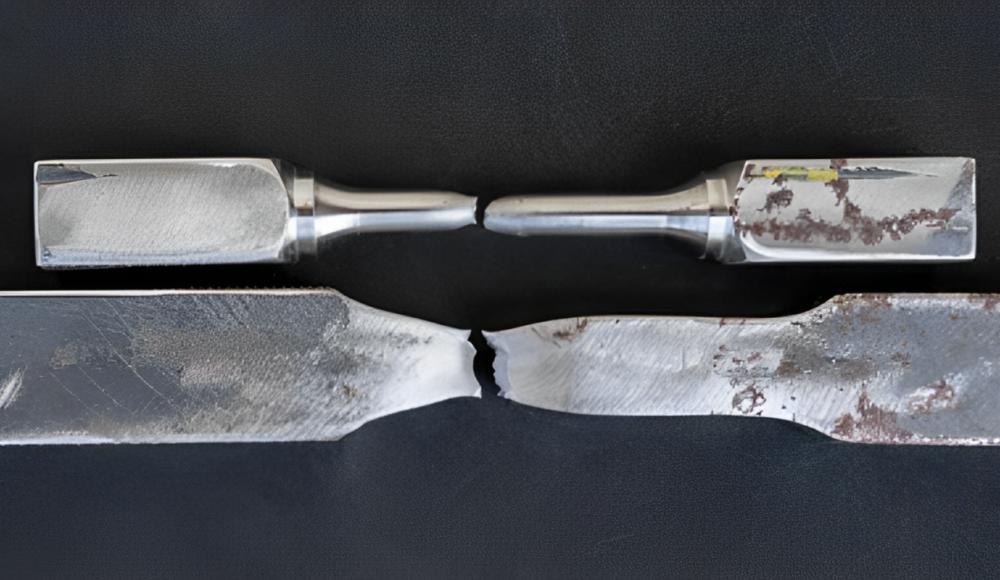L'ingénierie et la science des matériaux ne peuvent exister sans connaître les définitions de la limite d'élasticité et de la résistance à la traction.. Ces deux propriétés définissent la façon dont les matériaux réagiront aux contraintes et aux charges.. La limite d'élasticité est le point où un matériau peut se déformer. La résistance à la traction est la charge maximale que nous pouvons appliquer à un matériau avant qu'il ne se brise.. Donc, cet article donne le détail des propriétés, formules, comparaisons, et la signification physique des deux propriétés. mis-à-part, nous discutons principalement de la comparaison entre la limite d'élasticité et la résistance à la traction.
Notions de base de la courbe contrainte-déformation
Cohésif stress ou tension est une courbe qui représente le changement de taille ou de forme d'un matériau soumis à une contrainte. Donc, quand le stress monte, les matériaux se comportent de manière élastique au stade initial et sont capables de retrouver leur forme initiale. Après, les limites d'élasticité donnent une étape de déformation élastique, et les changements sont permanents. Ici, le matériau se brise au niveau de la courbe et atteint la résistance à la traction ultime. Donc, au-delà de ce point, le matériau ne peut pas supporter le stress.
Qu'est-ce que la limite d'élasticité?
C'est le point sur la courbe contrainte-déformation où un matériau ne parvient pas à retrouver sa forme réelle après avoir appliqué une contrainte.. La déformation plastique est son degré de résistance à la déformation permanente, une caractéristique importante en génie structurel et mécanique. Des ingénieurs expérimentés utilisent la limite d'élasticité pour estimer la charge qu'un certain matériau peut supporter sans subir de déformation permanente..
Formule de limite d'élasticité
Nous pouvons calculer la limite d'élasticité (s_y) comme:
σy=Fy/Ao
Ici
Fy = force appliquée à la limite d'élasticité,
𝐴o = aire de la section transversale d'origine
Qu'est-ce que la résistance à la traction?
C'est aussi le résistance à la traction ultime (UTS)et fait référence au niveau de stress. Ici, les matériaux sont soumis à des opérations d'étirement ou de traction jusqu'à la rupture. Ici, la courbe contrainte-déformation est l'endroit où le matériau offre sa résistance maximale à la charge appliquée.. Après avoir atteint la résistance à la traction, il y a une région de striction; après cela, le matériau tombe en panne et se casse. La résistance à la traction est essentielle dans certaines applications pour garantir la compétence du matériau à adhérer à des contraintes élevées..
La formule de la résistance à la traction:
Nous pouvons calculer la résistance à la traction (St) comme:
σt = Ft/Ao
Où:
𝐹𝑡 = la force maximale que détient le matériau,
𝐴o = est l’aire de la section transversale d’origine du matériau.
Comparaison entre la limite d'élasticité et la résistance à la traction
Voici quelques-unes des différences courantes entre la limite d'élasticité et la résistance à la traction.:
1. Définition et objectif
YS et UTS sont extrêmement importants dans l'ingénierie des matériaux. Chaque propriété remplit des fonctions différentes, c'est à dire. analyser le comportement du matériau sous contrainte. La limite d'élasticité définit le niveau de contrainte auquel un matériau subit une déformation permanente et retrouve sa forme d'origine..
En traction (résistance à la traction ultime) est la contrainte la plus élevée qu'un matériau peut supporter avant de se briser. Ses applications de forces agissant le long d’une ligne d’action pour séparer une ligne similaire.
2. Courbe contrainte-déformation et position sur celle-ci
La limite d'élasticité est déterminée lors de la transition du segment qui décrit uniquement la déformation élastique à la partie suivante de la courbe contrainte-déformation présentant un changement de forme plus permanent.. La résistance à la traction peut être résolue par la valeur maximale - le point indiquant la contrainte de traction maximale qui est la capacité d'un matériau à résister aux charges jusqu'à la striction et la rupture..
3. Application dans la structure de construction
La limite d'élasticité est appliquée pour garantir que les structures ne se déforment pas sous l'effet des contraintes.. Par exemple, la limite d'élasticité affecte les éléments porteurs d'un bâtiment comme les colonnes ou un pont comme les poutres de support. Résistance à la traction, cependant, est suffisamment haut pour que les matériaux ne se brisent pas facilement face aux forces de traction.
4. Considérations sur les facteurs de sécurité
La limite d'élasticité est choisie comme limite de conception pour les facteurs de sécurité. Quelques matériaux pouvant franchir cette limite d'élasticité constituent une menace. Cette menace peut porter atteinte à l’intégrité de la structure et la déformer. La résistance à la traction offre une limite ultime pour le niveau de force. Parce qu'au-delà de ce niveau, une fracture se produit, ce qui est potentiel dans les applications à contraintes élevées.
5. Ductilité et fragilité des matériaux
La solidité des luminaires, mais aussi leur rigidité et leur insouciance contribuent également à ces atouts.. La limite d'élasticité coïncide souvent avec la ductilité, c'est, un tel matériau peut supporter des charges plus élevées avant de se déformer de façon permanente. En général, la résistance à la traction a tendance à être plus élevée dans les matériaux ductiles. Mais les matériaux fragiles pourraient également offrir une résistance à la traction élevée proportionnellement à la limite d'élasticité., ils pourraient se casser facilement.
6. Application dans la vie réelle et dans les industries
De plus, la limite d'élasticité est essentielle pour la forme du composant et ne nécessite pas de déformation permanente sous les charges habituelles. D'autre part, la résistance à la traction est importante dans des domaines tels que l'aérospatiale et l'automobile. Ici, les substances sont obligées de répondre au couple sans se fracturer..
7. Techniques utilisées dans les tests et les mesures
Même les procédures utilisées pour mesurer chaque propriété sont différentes. La limite d'élasticité peut être obtenue en effectuant une contrainte jusqu'au début de la déformation plastique ou en appliquant une contrainte qui conduit le matériau à subir une déformation plastique.; le rendement peut être déterminé à l'aide de méthodes de compensation telles que 0.2% pour les métaux. Cependant, la résistance à la traction est obtenue en appliquant une contrainte progressivement jusqu'à ce que la rupture ou la défaillance se produise..
8. Effet de la température et de l'environnement
La température et d'autres conditions peuvent affecter ces deux propriétés. L'élasticité peut réduire la limite d'élasticité du matériau. Puisque cela définit le niveau de contrainte qu'un matériau peut supporter sans déformation. La résistance à la traction dépend également de la température. Bien que la plupart des matériaux aient tendance à être plus résistants à haute température qu'à basse température.
| Propriété | Limite d'élasticité | Résistance à la traction |
| Définition | Contrainte à laquelle commence la déformation permanente. | Contrainte maximale avant rupture. |
| Point sur la courbe contrainte-déformation | Transition de la déformation élastique à la déformation plastique. | Pic avant la rupture du matériau. |
| Unités | MPa ou psi. | MPa ou psi. |
| Plage de valeurs typique | 200 MPa à 2500 MPa. | 250 MPa à 3500 MPa. |
| Importance | Indique la résistance à la déformation permanente. | Indique la charge maximale avant rupture. |
| Exemple d'application | Structures porteuses (par exemple., ponts). | Résistance extrême aux forces (par exemple., câbles). |
| Comportement des matériaux | Résistance au changement permanent. | Résistance à l'échec. |
Rendement et résistance à la traction comme indicateurs de performance clés
La limite d'élasticité et la résistance à la traction sont toutes deux importantes pour qu'un matériau puisse analyser sa capacité.. Donc, il peut aider à maintenir la résistance structurelle sous contrainte afin qu'elle ne change pas de forme et de taille. La résistance à la traction révèle la contrainte maximale qu'un matériau peut supporter sans rupture, applicable aux matériaux soumis à des forces extrêmes. Tout à fait, ils orientent les choix faits en matière de matériaux et de formes pour assurer la sécurité et la fiabilité.
Application de la limite d'élasticité et de la résistance à la traction dans le monde réel et exemples
Voici quelques exemples en temps réel de limite d'élasticité par rapport à la résistance à la traction.:
1. Bâtiment et Génie Civil
La résistance à haut rendement des structures telles que l'acier et le béton joue un rôle essentiel. Donc, il peut maintenir la structure physique du complexe sous haute pression. Certaines propriétés présentées par les câbles utilisés dans les ponts suspendus comprennent; résistance à la traction. Cela décourage les câbles de se briser sous des forces plus importantes.
2. Industrie automobile et aérospatiale
Dans les applications automobiles, la limite d'élasticité empêche la déformation lors d'accidents. La résistance à la traction empêche la pièce de se briser. Ces matériaux aérospatiaux peuvent posséder à la fois des propriétés pour supporter le poids de la charge volante et des conditions difficiles..
3. Fabrication de produits industriels et machinerie lourde
Les propriétés mécaniques requises des engrenages et des pièces de machine incluent une résistance élevée à la traction pour éviter toute défaillance sous des charges., tandis qu'une limite d'élasticité élevée est souhaitable pour les châssis de la machine afin d'éviter toute déformation pendant l'utilisation.
4. Implants et dispositifs médicaux
Les matériaux couramment utilisés dans les implants médicaux comprennent le titane et l'acier inoxydable.. Donc, il est important d'avoir une limite d'élasticité et une résistance à la traction élevées pour éviter la déformation et/ou la fracture.
5. Équipement sportif
La limite d'élasticité et la résistance à la traction sont importantes pour les matériaux correspondants dans les équipements sportifs, c'est à dire., vélos et raquettes de tennis en fibre de carbone. Il doit nécessiter plusieurs cycles de contrainte/déformation sans diminuer les performances ou l'intégrité du matériau..
Points communs entre le rendement et la résistance à la traction
Voici quelques aspects courants de la limite d'élasticité et de la résistance à la traction.:
- Les deux mesurent la résistance du matériau: La limite d'élasticité et la résistance à la traction sont deux éléments utilisés pour évaluer la résistance d'un matériau.. Donc, il peut résister aux contraintes de force sans défaillance.
- Clé pour la conception structurelle: Les deux sont utilisés pour évaluer quel matériau convient aux structures civiles. Ces structures peuvent être des bâtiments, machines, et véhicules; pour ne pas s'user facilement.
- Aide à prédire le comportement des matériaux: Les deux sont très importants pour prédire le comportement des matériaux sous charge.. Ils peuvent choisir la conception du produit pour résister à certaines conditions de stress.
- Important pour la sélection des matériaux: Les deux sont cruciaux dans le choix des matériaux appropriés pour diverses industries. Donc, il peut garantir que les matériaux fonctionnent efficacement et en toute sécurité dans diverses conditions.
- Mesuré via des tests de traction: La limite d'élasticité et la résistance à la traction sont testées par des méthodes d'essai de traction, dans lequel la contrainte et la déformation sont mesurées pour déterminer des valeurs caractéristiques dans le diagramme contrainte-déformation.
Conclusion
En conclusion, La limite d'élasticité et la résistance à la traction sont des attributs importants des matériaux qui sont primordiaux dans l'ingénierie et la caractérisation des matériaux.. La limite d'élasticité est la mesure de la résistance d'un matériau à la déformation en un point particulier et la résistance à la traction est une mesure de la contrainte maximale.. Ces propriétés nous renseignent sur la résistance à laquelle un matériau peut résister avant de se briser.. Tous deux sont importants pour garantir la fiabilité et la durabilité des structures, produits, et systèmes. Ces systèmes peuvent inclure des travaux de construction, automobile, et industries aérospatiales, etc.. Ainsi, les concepts ci-dessus aident les ingénieurs à identifier les bons matériaux à utiliser en fonction des normes de performance requises..
FAQ
Quelle est la différence entre les termes limite d'élasticité et résistance à la traction?
La limite d'élasticité est une étape à laquelle se produit la formation d'une déformation plastique permanente. D'autre part, la résistance à la traction est la charge maximale qu'un matériau peut supporter avant sa rupture.
Quelles sont les méthodes de mesure de la traction et de la limite d'élasticité?
Ces deux éléments sont déterminés à l'aide d'un essai de traction dans lequel un petit échantillon du matériau est tiré.. Donc, il peut enregistrer les valeurs de contrainte-déformation et obtenir ces propriétés.
Lequel des deux points forts est le plus utile pour un ingénieur en structure?
En effet, la limite d'élasticité est sans doute plus essentielle pour les applications structurelles.. C’est principalement dû à sa capacité à montrer quand un matériau s’est déformé plastiquement., ce qui peut provoquer une défaillance de la structure.








